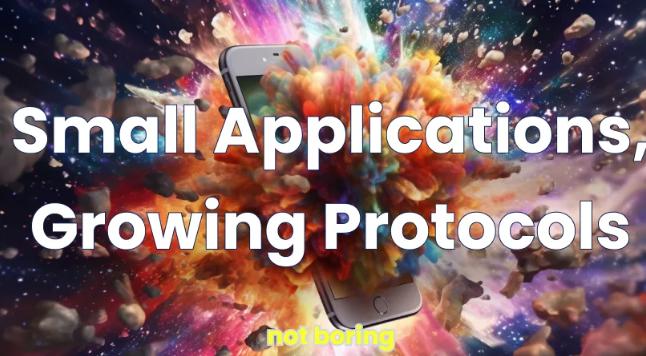Braintrust: A decentralized direct recruitment platform, a model of Web3 integrated into reality
Author: Packy McCormick, Not Boring
Original Title: 《Braintrust: Fighting Capitalism with Capitalism》
*Translation: Siqi, * Overseas Unicorn
The rise of DAOs has made people realize the ownership economy for the first time: a network owned, operated, maintained, and expanded by its users. More and more project teams are bringing this concept into upper-level applications in finance, social media, consumption, and society.
Braintrust defines itself in its white paper as a decentralized talent network: a talent network led by individual users and owned by them, with the ultimate goal of replacing traditional recruitment platforms. However, as a recruitment platform aimed at the "gig economy," Braintrust appears similar to other job platforms at first glance; in today's popular language, it is a Web2 product.
By introducing the concept of DAOs and governance token schemes, Braintrust aims to gain a competitive market advantage through extremely low platform commissions, challenging the unfair practices of Web2 companies towards users. Braintrust further integrates the Web3 concept into everyday life, while also riding the wave of the open network and cryptocurrency era for rapid development.
So far, over 34,000 freelancers have joined the Braintrust ecosystem, with global companies including Twitter, Porsche, Goldman Sachs, and Nike offering over 1,500 positions on the platform. 85% of the platform's users have their own digital wallets. In December 2021, Coatue and Tiger invested $100 million in Braintrust in the form of token purchases.
Braintrust is not a brand new product or business model, but by merging existing business models with the spirit of Web3, it may be a positive practice for bringing Web3 into the real world. However, layering the Web3 concept does not necessarily mean it is better than existing alternatives; there are still numerous challenges to face in the development of Braintrust.
01. Braintrust: Web3 Integrated into Web2 Business Practice
The most exciting aspect of Web3 is that it brings new business models and a new value chain that emerges after removing "intermediaries."
Braintrust defines itself in its white paper as a decentralized talent network: a talent network led by individual users and owned by them, with the ultimate goal of replacing traditional recruitment platforms.
However, as a recruitment platform primarily serving the "gig economy," Braintrust appears similar to other job platforms at first glance; in today's popular language, it is a Web2 product. Currently, nearly 40% of workers in the U.S. are freelancers, with a market size of approximately $1.5 trillion. The impact of the pandemic has accelerated online and remote collaboration, making the trend of "freelancing" more long-term, fixed, and widespread, with the number of freelancers and the economic scale growing exponentially.
As the market has a sufficient and diverse supply of freelancers, more and more companies are choosing to outsource certain functions to focus more on building core business capabilities. This work model has created millions of job opportunities and driven the growth of the freelance economy, changing traditional employment relationships.
Freelancers and the gig economy have enormous market potential: the publicly listed gig recruitment platform Upwork (valued at nearly $3 billion) achieved a transaction volume of $904 million in Q4 2021, while Israel's leading company in this sector, Fiverr, had a transaction volume of $260 million and a market value of $2.7 billion.
Braintrust has seized the trend of the booming gig economy, matching knowledge-based freelancers from around the world with top companies like Nike, Deloitte, Nestlé, and NASA through its platform. Braintrust's revenue comes from commissions; once a successful hire is made, companies need to pay Braintrust a service fee of 10% of the labor contract amount, which is significantly lower than the 30%-40% commission rates of platforms like Upwork, Fiverr, and Toptal.
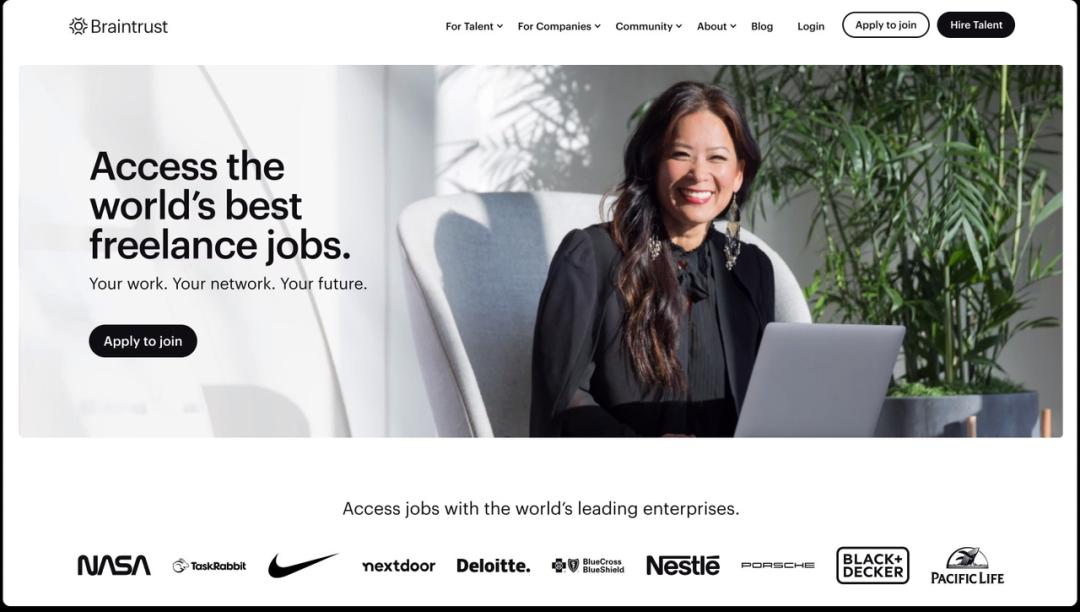 Braintrust Homepage
Braintrust Homepage
What sets Braintrust apart from other platforms like Upwork is that it does not want to be an "intermediary." By introducing the concept of "decentralization" and a token system, Braintrust aims to leverage the power of Web3 to maintain low commission rates continuously, thereby gaining an advantage in market competition.
Braintrust was launched in 2018, and the platform officially started in June 2020. Its early investors include Variant, Multicoin, ACME, Hashkey, and Pantera, among others. Multicoin Capital has also invested in many similar companies like Helium, Arweave, and Livepeer, which all use Web3 methods to comprehensively address the real issues brought by centralization. In September 2021, Braintrust raised $11 million through Coinlist crowdfunding and issued the governance token $BTRST, beginning governance in the form of a DAO. Its early investors hold 22% of Braintrust's tokens, with another 5% allocated to crowdfunding participants, while the remaining portion is reserved for early contributors and the community.
In December 2021, Coatue and Tiger invested $100 million in Braintrust through token purchases. Currently, Braintrust's fully diluted market capitalization is $896 million.
Braintrust focuses on engineers, designers, and developers, connecting tech knowledge workers with top companies. Because it emphasizes the Web3 and decentralization concepts, Braintrust can more easily attract the attention of this group, with 85% of users on the platform owning their own digital wallets.
So far, over 34,000 freelancers have joined the Braintrust ecosystem, with top global companies including Twitter, Porsche, Goldman Sachs, and Nike offering over 1,500 positions on the platform. According to Braintrust's official data dashboard, since its launch in June 2020, Braintrust has completed a total of 2,373 job requests, with an average contract amount of $72,500 (calculated as: project weeks x hours/week x hourly rate).
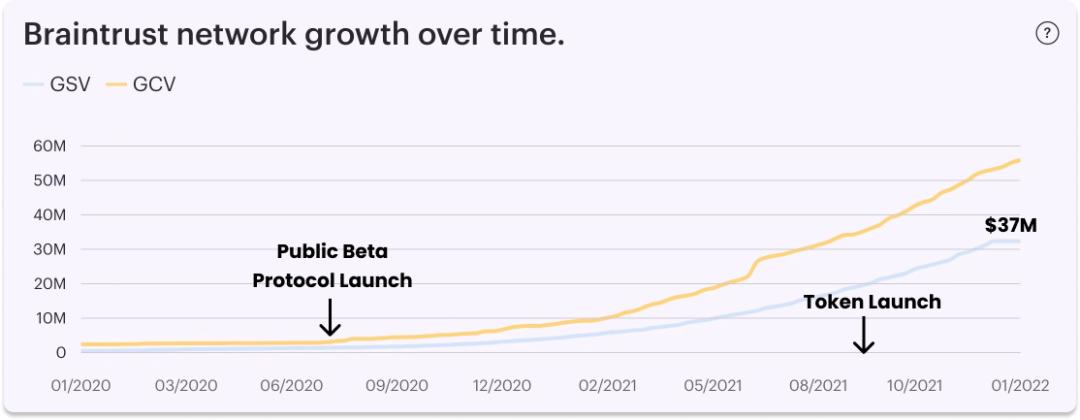 Braintrust Network Dashboard
Braintrust Network Dashboard
Even with its own token, Braintrust adheres to one principle: a good token economy can amplify a platform's value, but it cannot completely replace it.
Therefore, Braintrust does not rely on token incentives to attract users but aims to attract knowledge workers and companies through the following aspects:
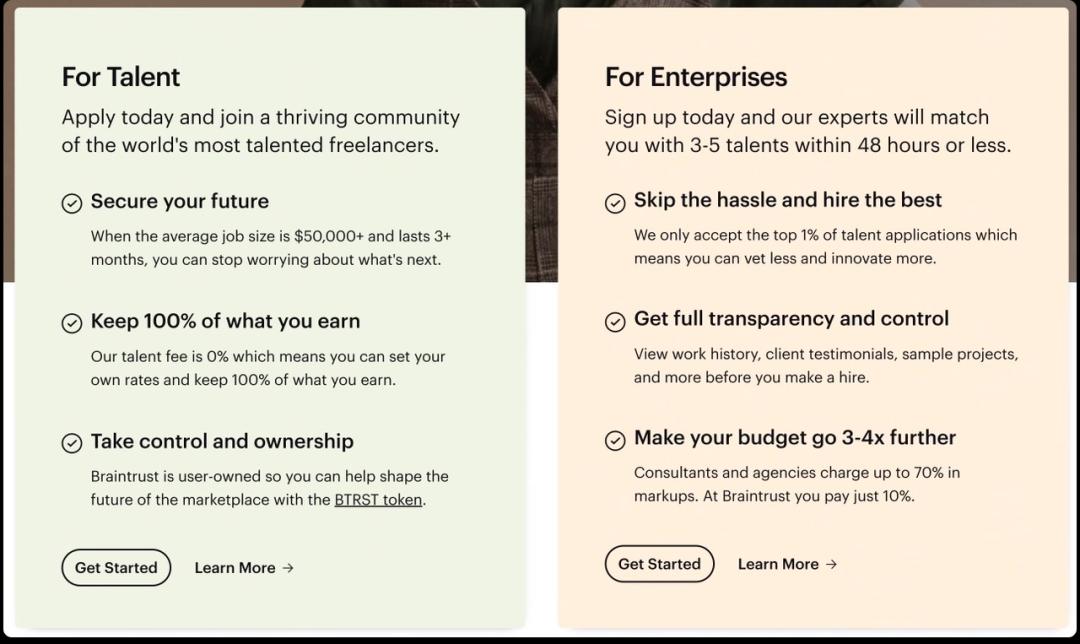 Braintrust
At the same time, based on the DAO operational concept, Braintrust users holding the platform token can participate in a series of decision-making votes regarding platform operations. For freelancers, when their income is strongly tied to the platform, Braintrust provides a mechanism to ensure that trust between users and the platform is not undermined by external factors.
Braintrust
At the same time, based on the DAO operational concept, Braintrust users holding the platform token can participate in a series of decision-making votes regarding platform operations. For freelancers, when their income is strongly tied to the platform, Braintrust provides a mechanism to ensure that trust between users and the platform is not undermined by external factors.
Braintrust is not a brand new product or business model; it integrates the Web3 concept to make more avant-garde improvements to the business model of trading platforms.
However, from a business practice perspective, it still faces the reality of whether a decentralized, user-owned and led trading platform can be more efficient than Web2 (investor-owned) trading platforms.
Braintrust cannot guarantee success solely because of its Web3 attributes; it also faces strong competitors from "the traditional world," such as Toptal, Gigster, traditional staffing agencies, and Recruiter.com.
02. The "Original Sin" of Web2 Trading Platforms "Your margin is my opportunity." Braintrust's founder Adam Jackson borrowed this perspective from Amazon's founder Bezos to describe Braintrust's starting point and long-term competitive advantage.
As a serial entrepreneur and investor, Adam Jackson has extensive experience in platform-type product startups and has participated in the establishment of four venture capital firms and one asset management company over the past 16 years.
In 2012, he co-founded the medical service organization Doctor On Demand, raising $165 million. In 2017, he co-founded the blockchain asset management company Cambrian Asset Management. Adam is also an angel investor in over 100 companies/projects, including Eco, Collective, Ethereum, Bolt, Placer, Aktana, Skale Labs, Protocol Labs, JCTurbo, Apero Health, Rappive, MyTime, Automatic, Womply, Superhuman, Zenefits…
Braintrust's co-founder Gabriel Luna-Ostaseski founded a consulting firm for startups called Upshift Partners, aimed at providing development and customer growth consulting services for tech companies in Silicon Valley, with clients including Thumbtack, Uber, Lending Home, Metromile, Massdrop, and others.
The founding of Braintrust by Adam Jackson and Gabriel Luna-Ostaseski is rooted in their profound insights from entrepreneurial investments in the Web2 space.
Over the past decade, a series of innovative companies have emerged in the Web2 space that significantly impact people's lives, with daily life largely revolving around these platforms. A typical scenario is: A New Yorker ordered dinner on DoorDash last night, took an Uber home the night before, and booked a room on Airbnb in advance for next week's trip.
Even after the recent plunge in U.S. stocks, their total value still reaches hundreds of billions of dollars:
 However, the business models of these trading platforms also face challenges:
However, the business models of these trading platforms also face challenges:
To form their own network effects, these platforms need to incur substantial costs in their early growth stages to complete the continuous cycle of "customer acquisition, growth, and retention." In this process, intensified market competition not only raises these costs but may also render the significant costs already incurred "wasted," as exemplified by the battle between Uber and Lyft.
When the supply on the platform cannot fully meet demand, the platform may sacrifice the quality standards of the supply, leaving users on the platform with no other choice but to leave, such as Amazon's shift from fully self-operated to introducing third-party sellers.
From a revenue model perspective, successful trading platforms (marketplaces) inevitably move towards advertising; advertising is a business model validated and adopted by almost all companies, but it severely impacts customer experience.
More importantly, almost all trading platforms, once they realize that users/participants on the platform are sufficiently locked in and unlikely to leave, will raise platform commission rates to increase profits.
These scenarios are likely to occur in the development process of every trading platform.
From the perspectives of user fairness and platform sustainability, Adam does not believe that the high commission revenue model of Web2 platforms is sustainable.
A significant portion of innovation in Web2 trading platform companies (products) lies in their mobilization of social supply, introducing new supply-demand relationships to existing markets, thereby elevating market size to a new level: Airbnb expanded the vacation rental market by providing non-hotel types of accommodation, and the travel market's scale was broadened by Uber's "shared car" concept beyond just taxis.
In Adam's view, most Web2 platforms' innovations are about monetizing individual resources, but the monetization benefits are "captured" by the platform, and individual users who contribute to the platform's growth do not receive their fair share of benefits.
Now, let's look at the issue of rising commission rates.
Although the user experience is poor, from the perspective of company management, raising commission rates is not a bad thing; successfully increasing platform commission rates is an extremely important positive business signal. For example, Fiverr recently highlighted in its shareholder letter that its commission rate increased by 140% compared to the previous year. From the platform's development stage, the increase in commission rates often occurs earlier than the business truly stabilizes because platform operators need to prove to shareholders that they can achieve profitability sooner. Meanwhile, in fierce market competition, platforms are forced to sacrifice some revenue to offer a lower (but not sustainable) commission level, so the timing for raising commission levels is again moved forward.
Chris Dixon from a16z mentioned in Why Decentralization Matters that a certain situation will inevitably occur on centralized trading platforms: Once a platform establishes its own network effects and is confident that all parties involved on the platform—users, service providers, and even developers—begin to depend on the platform, the platform will choose to shift from "attracting these people" to "extracting value from this group." A positive interpretation of raising commission rates is: raising commission rates can demonstrate that "the value of the trading platform is increasing."
If a platform can successfully raise its commission rate from 10% to 20% without any friction, it indicates that their product has become more valuable to users.
However, "without any friction" is a critical prerequisite; once the platform's commission rate exceeds what users consider fair, it will sow the seeds for the platform's decline.
Benchmark partner Bill Gurley articulated a classic viewpoint in "The Best Platform Pricing Strategies": the shortsightedness of platforms in setting commission rates is very dangerous; in the short term, raising commission rates can yield positive feedback for profit growth, but if you want your platform to maintain an advantage in the long term, this behavior is strategically suboptimal, as raising commission rates may lead both supply and demand sides to leave the platform in search of alternatives.
Gurley's advice is that platforms should not continuously raise the fees charged to users but should find ways to earn more revenue from those trying to acquire more users from them, such as through advertising.
To some extent, Adam Jackson of Braintrust and Gurley share the same view; from the perspective of user fairness and platform sustainability, Adam Jackson believes that relying on commissions is detrimental to platform development, but he has chosen Web3 as the tool to solve the problem. 03. How Braintrust Operates
For businesses or individual users on the Braintrust platform, understanding blockchain does not affect usage; anyone can participate in Braintrust, whether posting jobs, recommending talent, or investing and voting on governance. In general, Braintrust aims to address three main issues present in traditional recruitment platforms:
Fairer fee structure: Recruitment platforms like Toptal, Upwork, and Gigster charge high fees of 30-60%, which increases recruitment costs for companies while reducing the actual income of freelancers, which is unfair.
Higher quality talent supply: Braintrust focuses on high-level knowledge talent, with all users undergoing peer-to-peer verification and KYC processes. For corporate clients, Braintrust brings the background check process upfront, providing them with a vetted, high-quality "talent pool." Blockchain technology can also provide a systematic reputation storage and tracking tool to improve recruitment quality, which we will elaborate on later.
Misaligned interests: The centralized ownership structure creates a disconnect in interests between platform operators and actual users; to maintain a long-term advantage, this misalignment needs to be changed.
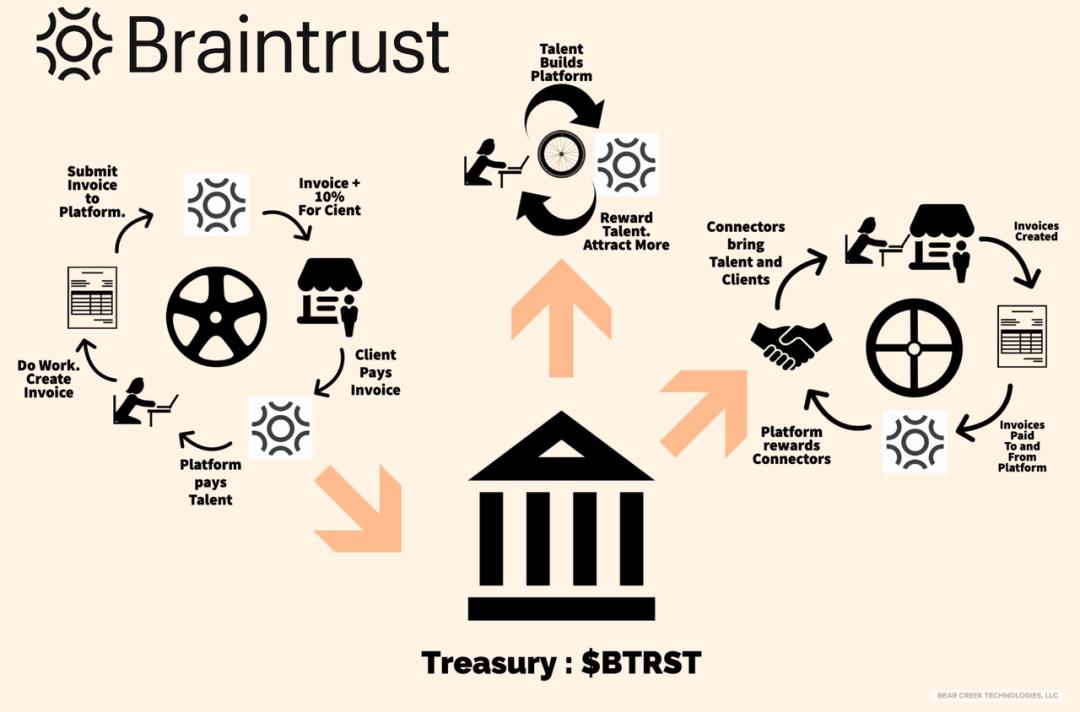 Talent, Employer, and Connector
In addition to talent and employers, Braintrust introduces the role of "Connector," consisting of these three specific stakeholders. Every user wishing to register must first pass the platform's KYC (Know Your Customer) process; only after passing can they become a platform member.
Talent, Employer, and Connector
In addition to talent and employers, Braintrust introduces the role of "Connector," consisting of these three specific stakeholders. Every user wishing to register must first pass the platform's KYC (Know Your Customer) process; only after passing can they become a platform member.
From the recruitment business chain perspective, Connectors can be seen as third-party recruiters on the platform, which can be individuals or organizations. In theory, both talent and employers can also serve as Connectors.
The job information posted by employers is visible not only to potential talent but also to Connectors. When Connectors successfully match candidates to job positions through targeted recommendations, Braintrust rewards them with a certain amount of platform tokens $BTRST based on the contract amount.
The introduction of the "Connector" role maintains the dynamic flow and growth of the Braintrust platform: they continuously invite new clients and knowledge workers to join Braintrust, assisting in recruitment and job matching. "Connectors" can also be seen as a Go-To-Market strategy for Braintrust; the "cash-for-growth" approach used by other platforms transforms into a token scheme here, which is a key reason Braintrust can maintain a low commission rate of 10% in the long term.
The connection between employers and talent follows a Bid-Ask process. "Ask" refers to employers, who specify the talent criteria they need, such as skills, experience, location, salary, etc. Contracts automatically match these conditions with the "Bids" of freelancers on the platform, and the entire matching process is executed automatically by the protocol.
Braintrust also allows both employers and talent to rate each other after completing a project, and receiving a five-star rating can earn them token rewards, which serve as both income and a form of reputation certification stored on-chain.
Next, Braintrust will systematically build its on-chain reputation system. In the Web2 context, individuals' work history and job-related data cannot be shared across platforms; for example, Toptal's profile cannot be queried on Fiverr. The closed nature of systems prevents freelancers from having complete reputation certifications, but these issues can be resolved through blockchain technology.
Compared to competitors, Braintrust not only has lower commissions but is also highly efficient: according to publicly available information, Braintrust's matching algorithm maintains an 80% matching rate, connecting clients (companies) with 4 to 7 freelancers within the first 24 hours after a job is posted. The entire matching process averages 48 hours, whereas the time spent by employers on other platforms is around 2 weeks.
Service settlements between talent and companies are conducted in local fiat currency to avoid income fluctuations due to token payments.
Initially, companies paid Braintrust a service fee of 10% of the contract amount in cash, which was used as "labor costs" to pay various nodes that assisted in building Braintrust. After a recent community governance vote, this was changed to companies first paying the fee nodes in fiat currency, with the nodes responsible for converting the fiat to USDC and then using it to repurchase $BTRST tokens from the open market, thereby ensuring fund balance.
$BTRST and Braintrust's DAO Governance In addition to its business philosophy, the founding process of Braintrust also gives it a sense of social experimentation. In reality, there is no company entity named Braintrust Inc.; the entire Braintrust project is constructed mainly by five nodes:
Freelance Labs
HexOcean
SnowFork
Accelerated Labs
Muses
These organizations help Braintrust complete everything from protocol and token model design to early marketing, payment processing, and currency exchange functions, including all the preparatory processes needed to establish partnerships with companies like Nike, NASA, and the U.S. Space Agency. As early contributors to Braintrust, these node organizations hold 19% of the tokens.
Braintrust has issued a total of 250 million $BTRST tokens, of which 54% are used as community incentives to maintain the operation of Braintrust DAO. $BTRST is not used for payments but primarily for governance and rewards within Braintrust.
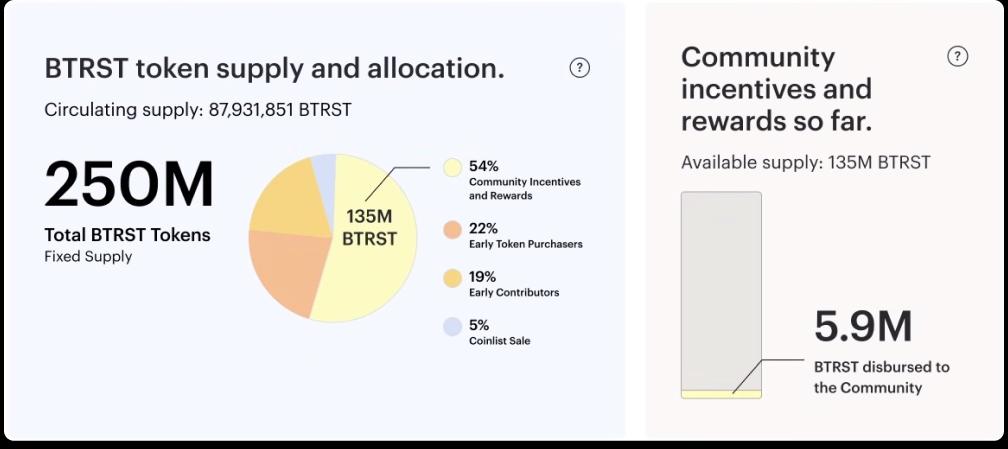 1. Governance
1. Governance
$BTRST is the governance token of Braintrust, allowing token holders to elaborate proposals on the Vote page. Community members vote on snapshot, and the results are reflected on-chain. Community members can vote on Braintrust's roadmap, fee schemes, reputation, and token mechanisms.
2. Dispute Resolution
Payments for labor compensation on Braintrust are not completed on the blockchain, and the platform currently does not support any escrow services. Therefore, for labor disputes, Braintrust cannot coordinate disputes from the perspective of freezing funds. However, as a platform, it is necessary to show its stance when conflicts arise between clients and talent.
Since Braintrust's dispute resolution process occurs off-chain (e.g., judicial arbitration), the $BTRST token governance mechanism indirectly addresses disputes in community operations. Participants in the resolution jury must either hold BTRST tokens or be selected as jury arbitrators by BTRST holders.
3. Incentivizing the Talent Network
$BTRST is also used to incentivize stakeholders on the platform, with several main types of contributors eligible for community rewards:
Connectors: Individuals who recommend talent or clients to the network. Anyone can become a Connector and recommend talent. Rewards for Connectors are currently the primary expenditure of Braintrust tokens.
Verifiers: Members responsible for the platform's KYC process, screening and reviewing the talent pool to ensure that applicants meet Braintrust and corresponding company standards. To become a verifier, one must complete the Braintrust Academy course and earn tokens for it, then receive $BTRST tokens after completing the screening.
Talent: From the moment of registration, talent can receive platform token rewards at different nodes, such as completing personal profiles, participating in platform courses, and successfully completing work.
Project Donations: Considering the increasing diversity of contributors on the platform, Braintrust has launched its own incentive program, mainly divided into three categories: ambassador rewards, developer rewards, and content creation rewards. The $100 million from Coatue and Tiger is also allocated to this program.
04. Risks and Upgrades of the Token Economy
Inflation Risk
The illustration in the white paper effectively showcases a complete photo flow on the platform and how the $BTRST token (the position of the logo in the image) plays a role:
 Braintrust White Paper
The positions marked with the "$" symbol correspond to interactions between companies and talent, just like they do on other trading platforms, exchanging work for cash. The areas marked with the Braintrust token logo represent the combination of Braintrust's token economy and platform rules:
Braintrust White Paper
The positions marked with the "$" symbol correspond to interactions between companies and talent, just like they do on other trading platforms, exchanging work for cash. The areas marked with the Braintrust token logo represent the combination of Braintrust's token economy and platform rules:
Connector rewards, as mentioned earlier, Braintrust uses platform tokens to pay its customer acquisition costs;
Compared to other platforms, on the Braintrust platform, talent not only does not have to pay intermediary fees but can also earn additional income beyond labor compensation: when they successfully apply for a job and receive a five-star rating from the employer after completing the work, they can earn platform token rewards. Besides serving as proof of their participation in community governance, the appreciation of $BTRST also brings them potential economic benefits.
There is a subtle balance here.
The rapid growth of freelancers and corporate clients on the platform enhances Braintrust's network effects as a platform, but when the number of talent and job positions increases and circulates rapidly on the platform, the circulating amount of $BTRST also increases, leading to natural inflation of the $BTRST token:
If participants (freelancers, employers) merely hold $BTRST tokens as platform activity participants, inflation's dilution of the token price will not significantly impact them;
However, if viewed from a financial investment and economic benefit perspective, inflation has a substantial impact on token holders.
The above two points will not overly affect job seekers and companies, as the economic benefits brought by the appreciation of $BTRST are not their core reason for coming to Braintrust. But for Connectors, the dilution of $BTRST's value will certainly affect their motivation to actively promote the operation and growth of Braintrust; in extreme cases, Connectors may choose to leave Braintrust if they see little economic benefit.
Considering the potential sell-off behavior after the lock-up period for early investors ends, the risk of $BTRST depreciation seems to be amplified. Even though Braintrust has set a cap of 250 million tokens for $BTRST to avoid inflation, the short term will test the mindset of financial investors.
Ideally, as a governance certificate for the community, this mechanism can ensure that most $BTRST can truly be enjoyed by those who need the Braintrust platform. However, considering that the key reason Braintrust can maintain a 10% cash commission rate is that it uses tokens to replace cash customer acquisition costs, it is unrealistic to disregard the financial value that $BTRST brings to its holders.
Holders of $BTRST may hope that these tokens will have direct financial value over time, but in the meantime, they have indirect financial value for network participants, primarily reflected in the following three aspects:
Community Governance. Participation in governance on the Braintrust platform can bring financial value, as it may mean that Braintrust can modify its commission rates, requiring companies to pay higher fees, with this portion of "profit" enjoyed by community members.
Job Application Staking. Clients and talent can stake $BTRST to demonstrate their willingness to participate, thereby standing out in the matching process: for example, if an applicant stakes 2 $BTRST to qualify for a priority interview for a design position at Nike, but fails to attend the interview, the tokens will be forfeited. To some extent, this serves as a Web3 alternative to the advertising model used by Web2 platforms.
Career Benefits. This aspect has not yet been implemented, but the Braintrust website has hinted at benefits that token holders may enjoy in the future: free career education content, software, or job coaching, etc.
To give a more intuitive simple example:
For an investor holding $BTRST purely for financial purposes, if one $BTRST token is worth $4, then the actual value they receive is also $4;
But for a job seeker on the Braintrust platform, if staking 1 $BTRST increases their chances of obtaining a $72,000 job by 0.01%, then for them, the actual value of 1 $BTRST at that moment is $4 + $7.20, which equals $11.20.
This does not consider the situation where the job seeker does not get the job; it merely illustrates the overall logic.
Additionally, if the token economy is designed well enough, it can also incentivize those holding tokens purely for financial investment purposes to actively participate in network building.
For example, if I hold $BTRST tokens but do not contribute new talent or job supply to Braintrust, I am effectively harming the value of $BTRST. The choice then becomes: should I recommend talent to the network and help them bid to establish their reputation, thereby enjoying the benefits brought by $BTRST? The answer is naturally affirmative.
Value Accumulation and Protocol Upgrades Because the flow of tokens and cash on the platform is mixed, Braintrust's token incentive mechanism has undergone an upgrade.
As mentioned earlier, Braintrust was built by several node teams. Until September of last year, Braintrust had not released its own tokens, but prior to that, Braintrust had to pay for the work of these nodes. Therefore, initially, the 10% service fee paid by employer companies to Braintrust would directly flow to these node organizations as their service fees.
However, the ensuing problem was that the incentives given to the community by Braintrust were one-way expenditures from the fund pool; when the fund pool did not receive supply, the incentives were also unsustainable. As shown in the image below:
 There is no connection between paid fees and tokens
In September, when Braintrust publicly issued its tokens, it decentralized and became a DAO, officially transferring governance rights to token holders. In October, holders of $BTRST voted to approve significant changes to the Braintrust token economy model.
There is no connection between paid fees and tokens
In September, when Braintrust publicly issued its tokens, it decentralized and became a DAO, officially transferring governance rights to token holders. In October, holders of $BTRST voted to approve significant changes to the Braintrust token economy model.
Specifically, "all fees on the platform, including current customer success fees and any future fees that may be initiated, must be paid in $BTRST rather than in cash to the nodes." This does not mean that corporate users must hold $BTRST to complete the payment of the 10% service fee.
In the actual process, 10% of the cash will first be given to the nodes responsible for receiving fiat (Fee Converter), which will convert this cash into stablecoin USDC and send it to the smart contract of the fee converter. The contract will then directly purchase $BTRST tokens from the exchange using this USDC and ultimately send them to Braintrust DAO to maintain the token's circulation.
This protocol upgrade does not continuously consume inventory but instead completes the self-sustainability of the fund pool with each 10% commission earned. Nodes will still receive compensation from the 10% fee, but since their initial development contributions to Braintrust have already received ample cash returns, moving forward, they will fully engage in their future work as contributors and earn BTRST token rewards like everyone else. After the protocol upgrade, the Braintrust community has purchased 145,000 $BTRST tokens on the open market. As a DAO, Braintrust's data is also completely transparent.
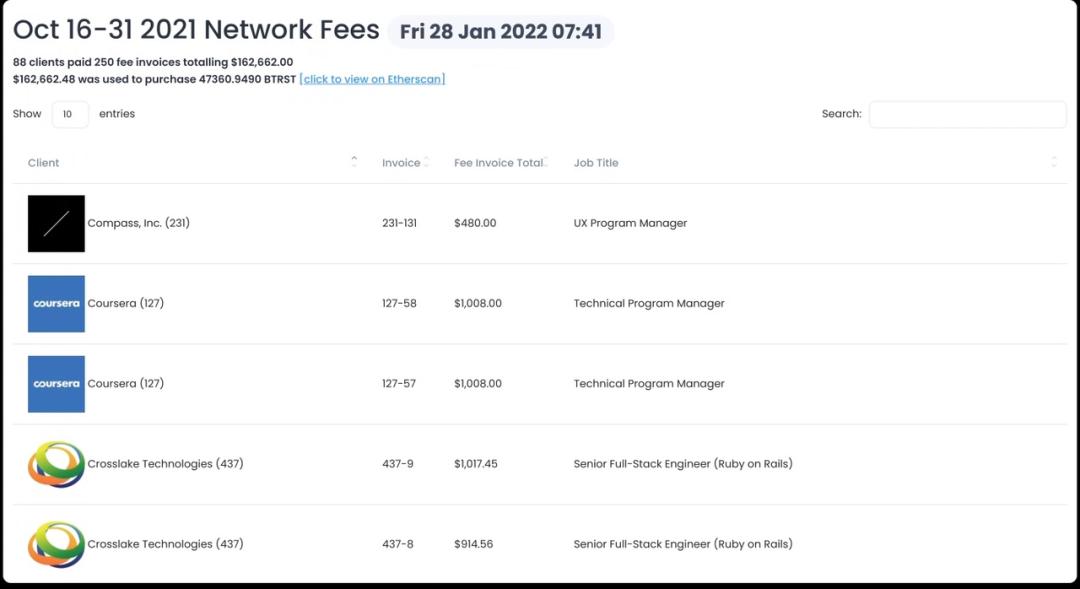
btrstinfo.xyz fee viewer The btrstinfo.xyz fee viewer is a typical representative; anyone can use this tool to see how much, when, and why clients on the platform have paid, and the details of work on the Braintrust platform can also be viewed as Braintrust's income details. Next, Braintrust will also launch a Twitter bot that will tweet things like "Nike just paid a $1,000 invoice and purchased 300 staked BTRST tokens." 05. How to Win?
The concept of Braintrust is actually quite simple: a bilateral trading platform with the least commission will have a competitive advantage, and a decentralized platform fully owned by users is more likely to have lower commissions.
It is important to emphasize again that this does not mean that trading platforms with Web3 elements and spirit will necessarily win in competition; they still need to provide excellent products and accomplish the arduous tasks required to operate in the market.
In a podcast, Braintrust's founder Adam mentioned that a reasonable commission rate charged by a trading platform is related to whether it provides unique value; once a company fails to do this, it will quickly be abandoned by users. Adam cited DoorDash as an example, arguing that DoorDash's rising commission essentially "steals" the tips that delivery personnel deserve, so such companies will be the first to "leave."
However, this argument is debatable, as it does not consider product complexity and average order value (in absolute terms, DoorDash's commission is not high), which is why it is unlikely that a decentralized Uber or DoorDash will exist.
On the other hand, Adam believes that Airbnb genuinely brings tremendous value to both sides of the market supply and has a reasonable commission rate as a platform. Therefore, if one were to create a Web3 version of Airbnb, the competitors it would face would be very formidable.
Although belonging to Web3 and Web2, Braintrust is making the same choice as Airbnb: the network with the least commission can solidify its operational space and have long-term value. Clearly, this concept does not necessarily mean that token participation is required; it is more about the proactive choice of the founders.
So back to the initial question: can a decentralized platform owned by users create and release more value?
According to Gurley and Bezos, a highly competitive trading platform can maintain low commission rates for as long as possible. Braintrust has achieved low commission rates, and what it needs to do next is to continue to maintain this advantage. As freelancers find it easier to secure quality, sustainable work through the Braintrust platform, Braintrust will enter a continuously growing positive cycle.
$BTRST tokens provide ownership and economic utility. So for platform participants, they need to clarify how much the value of "ownership" is. As of now, we are still discussing a platform that has only developed for 18 months, with a total service volume of $37 million, serving freelancers in the niche fields of engineers, designers, and developers.
An extreme imagination is: is it possible for Braintrust to cover all recruitment needs? Integrate more economic activities?
According to data from the Harvard Business Review, the size of the U.S. recruitment industry in 2019 was $151 billion. Therefore, it can be simply predicted that the global recruitment industry is approximately $450 billion. The income situation of third-party knowledge service agencies globally is as follows: Deloitte's revenue in 2021 was $50.1 billion, and TCS's was $22 billion. Adding these figures together, we can roughly estimate the salary scale of global knowledge workers to be around $600 billion.
Braintrust's commission rate is 10%, so theoretically, if Braintrust can build a machine that consolidates the global flexible talent market over time, it will have the opportunity to earn $60 billion per year in fees. In summary, the above prediction is an extreme inference, and achieving this prediction will take a long way to go, but in the coming months, it is foreseeable that Braintrust's coverage will extend beyond developers, engineers, and designers.
Entering the high-end knowledge service market occupied by giants like Deloitte, PwC, and Accenture is one option, leveraging additional services to gain a premium; these consulting firms can typically achieve a 70% commission rate. Recently, someone from an IT consulting background is researching a proposal to establish a new node, essentially a new startup built on the Braintrust protocol, which will receive funding from the aforementioned grant project once approved.
When the time is right, Braintrust's framework can also support it in competing against blue-collar gig platforms like Fiverr and Upwork, as "earning higher take-home income" is equally attractive to talent on platforms like Fiverr and Upwork.
At a certain scale, providing services and resources needed by the freelance talent pool also holds value, such as group health insurance or retirement plans.
In any case, new nodes will benefit from the infrastructure, community, and resources that the Braintrust network has built over the past four years. They will not need to raise funds separately to re-implement token model design, protocol design, and smart contract audits, as these have already been completed. They will utilize the existing pool of connectors and verifiers and will no longer need financing, as they can directly obtain startup funds from the DAO's fund pool.
Before truly confronting the giants of Web2, more realistic challenges have already emerged: the price of Braintrust's token peaked at over $40 after its launch on Coinbase but quickly fell; the mechanism for watching Braintrust Academy videos to earn $BTRST tokens faced exploitation by an army of bots. As Braintrust grows, a larger and more decentralized community than the current scale also poses challenges for DAO governance.





